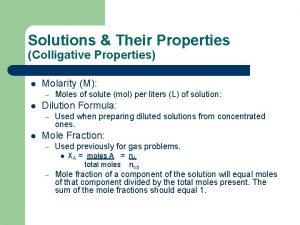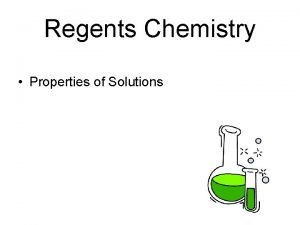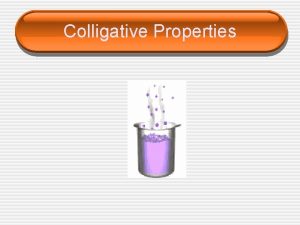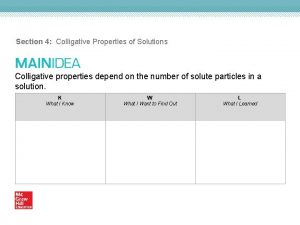Colligative Properties of Solutions chapter 16 Colligative properties













- Slides: 13

Colligative Properties of Solutions (chapter 16) Colligative properties = physical properties of solutions that depend on the # of particles dissolved, not the kind of particle.

Colligative Properties n n Lowering vapor pressure Raising boiling point Lowering freezing point Generating an osmotic pressure

2 to focus on… n n Lowering vapor pressure Raising boiling point Lowering freezing point Generating an osmotic pressure

Boiling Point Elevation n a solution that contains a nonvolatile solute has a higher boiling pt than the pure solvent; the boiling pt elevation is proportional to the # of moles of solute dissolved in a given mass of solvent. Like when adding salt to a pot of boiling water to make pasta

Boiling Point Elevation n Tb where: = k bm Tb = elevation of boiling pt m = molality of solute (mol solute/kg solvent) kb = the molal boiling pt elevation constant n kb values are constants; see table 16. 3 pg. 495 n kb for water = 0. 52 °C/m

Ex: What is the normal boiling pt of a 2. 50 m glucose, C 6 H 12 O 6, solution? n “normal” implies 1 atm of pressure Tb = kbm Tb = (0. 52 C/m)(2. 50 m) Tb = 1. 3 C n Tb = 100. 0 C + 1. 3 C = 101. 3 C n n n

Freezing/Melting Point Depression n The freezing point of a solution is always lower than that of the pure solvent. Like when salting roads in snowy places so the roads don’t ice over or when making ice cream

Freezing/Melting Point Depression n Tf = k fm where: Tf = lowering of freezing point m = molality of solute kf = the freezing pt depression constant n kf for water = 1. 86 °C/m n kf values are constants; see table 16. 2 pg. 494

Ex: Calculate the freezing pt of a 2. 50 m glucose solution. n Tf = kfm Tf = (1. 86 C/m)(2. 50 m) Tf = 4. 65 C n Tf = 0. 00 C - 4. 65 C = -4. 65 C n n

Electrolytes and Colligative Properties • Colligative properties depend on the # of particles present in solution. • Because ionic solutes dissociate into ions, they have a greater effect on freezing pt and boiling pt than molecular solids of the same molal conc.

Electrolytes and Colligative Properties n For example, the freezing pt of water is lowered by 1. 86°C with the addition of any molecular solute at a concentration of 1 m. – Such as C 6 H 12 O 6, or any other covalent compound n However, a 1 m Na. Cl solution contains 2 molal conc. of IONS. Thus, the freezing pt depression for Na. Cl is 3. 72°C…double that of a molecular solute. – Na. Cl Na+ + Cl- (2 particles)

Electrolytes - Boiling Point Elevation and Freezing Point Depression The relationships are given by the following equations: n Tf = kf ·m·n or Tb = kb·m·n Tf/b = f. p. depression/elevation of b. p. m = molality of solute kf/b = b. p. elevation/f. p depression constant n = # particles formed from the dissociation of each formula unit of the solute

Ex: What is the freezing pt of a 1. 15 m sodium chloride solution? n Na. Cl Na+ + Cl- n=2 n Tf = kf·m·n Tf = (1. 86 C/m)(1. 15 m)(2) Tf = 4. 28 C n Tf = 0. 00 C - 4. 28 C = -4. 28 C n n
 Freezing point chapter 13
Freezing point chapter 13 What are the three colligative properties
What are the three colligative properties La molalité
La molalité 4 colligative properties
4 colligative properties Molarity and molality are colligative properties.
Molarity and molality are colligative properties. Colligative property definition
Colligative property definition Colligative properties definition
Colligative properties definition Regents chemistry solutions practice problems
Regents chemistry solutions practice problems Colligative properties of milk
Colligative properties of milk Applications of colligative properties
Applications of colligative properties Colligative properties worksheet
Colligative properties worksheet Vant hoff factor of glucose
Vant hoff factor of glucose Colligative properties
Colligative properties Colligative properties depend on the _____.
Colligative properties depend on the _____.
























